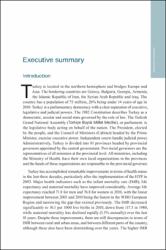Executive summary

Göster/
Erişim
info:eu-repo/semantics/openAccessTarih
2011Yazar
Tatar, MehtapMollahaliloğlu, Salih
Şahin, Bayram
Aydın, Sabahattin
Maresso, Anna
Hernández-Quevedo, Cristina
Üst veri
Tüm öğe kaydını gösterKünye
Tatar, M., Mollahaliloglu, S., Şahin, B., Aydın, S., Maresso, A. ve Hernández-Quevedo, C. (2011). Executive summary. Turkey: Health System Review 2011 içinde (XV-XX. ss.). Copenhagen ; WHO Regional Office for Europe.Özet
Turkey is located in the northern hemisphere and bridges Europe and Asia. The bordering countries are Greece, Bulgaria, Georgia, Armenia, the Islamic Republic of Iran, the Syrian Arab Republic and Iraq. The country has a population of 73 million, 26% being under 14 years of age in 2010. Turkey is a parliamentary democracy with a clear separation of executive, legislative and judicial powers. The 1982 Constitution describes Turkey as a democratic, secular and social state governed by the rule of law. The Turkish Grand National Assembly (Türkiye Büyük Millet Meclisi), or parliament, is the legislative body acting on behalf of the nation. The President, elected by the people, and the Council of Ministers (Cabinet) headed by the Prime Minister, exercise executive power. Independent courts handle judicial power. Administratively, Turkey is divided into 81 provinces headed by provincial governors appointed by the central government. Provincial governors are the representatives of all ministers at the provincial level. All ministries, including the Ministry of Health, have their own local organizations in the provinces and the heads of these organizations are responsible to the provincial governor.

















